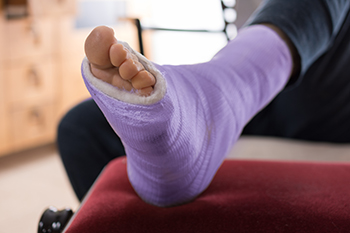
Heel spurs are bony growths that form on the underside of the heel bone, often resulting from long-term strain on the foot’s ligaments and tendons. They can be quite painful, typically resulting in a sharp, stabbing sensation in the heel, especially with the first steps in the morning or after prolonged periods of rest. Symptoms also include tenderness and swelling around the heel area. Treatment options for heel spurs include wearing supportive shoes with cushioned insoles, performing stretching exercises to alleviate tension in the foot, and using orthotic devices to correct alignment issues. In some cases, pain relief or anti-inflammatory medications may help manage discomfort. If you think you have heel spurs, it is suggested you make an appointment with a podiatrist who can provide a personalized treatment plan and address underlying issues.
Heel spurs can be incredibly painful and sometimes may make you unable to participate in physical activities. To get medical care for your heel spurs, contact Dr. Lubrina Bryant from District Podiatry, PLLC. Our doctor will do everything possible to treat your condition.
Heels Spurs
Heel spurs are formed by calcium deposits on the back of the foot where the heel is. This can also be caused by small fragments of bone breaking off one section of the foot, attaching onto the back of the foot. Heel spurs can also be bone growth on the back of the foot and may grow in the direction of the arch of the foot.
Older individuals usually suffer from heel spurs and pain sometimes intensifies with age. One of the main condition's spurs are related to is plantar fasciitis.
Pain
The pain associated with spurs is often because of weight placed on the feet. When someone is walking, their entire weight is concentrated on the feet. Bone spurs then have the tendency to affect other bones and tissues around the foot. As the pain continues, the feet will become tender and sensitive over time.
Treatments
There are many ways to treat heel spurs. If one is suffering from heel spurs in conjunction with pain, there are several methods for healing. Medication, surgery, and herbal care are some options.
If you have any questions feel free to contact our office located in Washington, D.C . We offer the latest in diagnostic and treatment technology to meet your needs.

Managing foot arthritis effectively involves incorporating specific exercises to maintain mobility and reduce pain. Gentle stretching exercises, such as toe stretches and Achilles tendon stretches, can enhance flexibility and alleviate stiffness. Strengthening exercises like towel curls, where you use your toes to scrunch a towel towards you, help build the muscles supporting the foot. Additionally, balancing exercises, such as standing on one leg, improve stability and support joint function. Low-impact activities, like swimming or cycling, provide a full range of motion without excessive stress on the feet. Regularly performing these exercises can reduce inflammation, increase foot strength, and improve overall comfort. If you have foot arthritis, it is suggested that you are under the care of a podiatrist who can help you better manage this condition.
Arthritis can be a difficult condition to live with. If you are seeking treatment, contact Dr. Lubrina Bryant from District Podiatry, PLLC. Our doctor can provide the care you need to keep you pain-free and on your feet.
Arthritic Foot Care
Arthritis is a term that is commonly used to describe joint pain. The condition itself can occur to anyone of any age, race, or gender, and there are over 100 types of it. Nevertheless, arthritis is more commonly found in women compared to men, and it is also more prevalent in those who are overweight. The causes of arthritis vary depending on which type of arthritis you have. Osteoarthritis for example, is often caused by injury, while rheumatoid arthritis is caused by a misdirected immune system.
Symptoms
Arthritic symptoms range in severity, and they may come and go. Some symptoms stay the same for several years but could potentially get worse with time. Severe cases of arthritis can prevent its sufferers from performing daily activities and make walking difficult.
Risk Factors
If you suspect your arthritis is affecting your feet, it is crucial that you see a podiatrist immediately. Your doctor will be able to address your specific case and help you decide which treatment method is best for you.
If you have any questions, please feel free to contact our office located in Washington, D.C . We offer the newest diagnostic and treatment technologies for all your foot care needs.

A dancer’s ankle and foot are marvels of flexibility and strength, designed to support high-impact movements and intricate footwork. Structurally, the foot comprises 26 bones, 33 joints, and numerous muscles and tendons that work in harmony to enable precise and graceful dance movements. However, this demanding use can lead to common problems like sprains, tendonitis, and stress fractures. One frequent issue is Achilles tendonitis, which arises from overuse or improper technique, causing pain and inflammation in the back of the heel. Another is plantar fasciitis, marked by sharp heel pain from inflammation of the tissue connecting the heel to the toes. Additionally, dancers are prone to metatarsal stress fractures due to repetitive stress on the foot bones. If you experience these issues with your feet or ankles, it is suggested you make an appointment with a podiatrist.
Ankle and foot injuries are common among athletes and in many sports. They can be caused by several problems and may be potentially serious. If you are feeling pain or think you were injured in a sporting event or when exercising, consult with Dr. Lubrina Bryant from District Podiatry, PLLC. Our doctor will assess your condition and provide you with quality foot and ankle treatment.
Common Injuries
The most common injuries that occur in sporting activities include:
Symptoms
Symptoms vary depending upon the injury and in some cases, there may be no symptoms at all. However, in most cases, some form of symptom is experienced. Pain, aching, burning, bruising, tenderness, tightness or stiffness, sensation loss, difficulty moving, and swelling are the most common symptoms.
Treatment
Just as symptoms vary depending upon the injury, so do treatment options. A common treatment method is known as the RICE method. This method involves rest, applying ice, compression and elevating the afflicted foot or ankle. If the injury appears to be more serious, surgery might be required, such as arthroscopic or reconstructive surgery. Lastly, rehabilitation or therapy might be needed to gain full functionality in the afflicted area. Any discomfort experienced by an athlete must be evaluated by a licensed, reputable medical professional.
If you have any questions, please feel free to contact our office located in Washington, D.C . We offer the newest diagnostic and treatment technologies for all your foot care needs.

Ankle fractures occur when one or more bones in the ankle joint break, often due to a fall, twist, or sports injury. Symptoms include intense pain, swelling or bruising, and difficulty moving the ankle. Treatment for an ankle fracture depends on the severity of the break. For minor fractures, elevating the ankle is recommended, along with immobilization using a cast or splint. More severe fractures may require surgical intervention to realign the bones and secure them with pins, plates, or screws. After surgery or immobilization, exercises help restore strength and mobility. Follow-up care with a podiatrist ensures proper healing and helps prevent complications. If you experience ongoing pain after an injury or suspect an ankle fracture, it's suggested that you make an appointment with a podiatrist who specializes in diagnosing and treating foot problems and can guide you through the recovery process to ensure optimal healing.
Ankle sprains are common but need immediate attention. If you need your feet checked, contact Dr. Lubrina Bryant from District Podiatry, PLLC. Our doctor can provide the care you need to keep you pain-free and on your feet.
How Does an Ankle Sprain Occur?
Ankle sprains take place when the ligaments in your ankle are torn or stretched beyond their limits. There are multiple ways that the ankle can become injured, including twisting or rolling over onto your ankle, putting undue stress on it, or causing trauma to the ankle itself.
What Are the Symptoms?
Preventing a Sprain
Treatment of a Sprain
Treatment of a sprain depends on the severity. Many times, people are told to rest and remain off their feet completely, while others are given an air cast. If the sprain is very severe, surgery may be required.
If you have suffered an ankle sprain previously, you may want to consider additional support such as a brace and regular exercises to strengthen the ankle.
If you have any questions please feel free to contact our office located in Washington, D.C . We offer the newest diagnostic and treatment technologies for all your foot and ankle needs.